Dec 2, 2020 1:08:44 PM
Retail | Operations
Dec 2, 2020 1:08:44 PM
Retail | Operations

2020 has thrown us a lot of curveballs. Whereas we used to talk about how businesses can go above and beyond, this year we’ve focused on simply weathering the storm.
But to get through this difficult period and thrive on the other side, it’s still important to look for ways to improve. One of the key areas of operations to focus on is site visit and audit procedures.
Efficient site visit prep, execution and data collection free up time for busy area managers to spend on training and coaching, which has become all the more important in the COVID-19 era.
With YOOBIC’s digitized platform, site visits have never been easier. Here are 5 ways YOOBIC can make your site visits and audits more efficient:
Find out more about YOOBIC’s site visit and audit platform here.
Every site visit form you complete is a goldmine of information about past performance.
But far too often, that valuable information is either not used to its full potential, or ignored completely. And without leveraging that data to guide you, any decision you make is essentially a stab in the dark.
With YOOBIC, all the relevant data from previous audits is right at your fingertips, which helps area managers prepare for the visit beforehand and create a tailored strategy for each site.
Not only that, but it also saves them valuable time during the visits, giving them more opportunity to actually implement any changes that need to be made.
RELATED: 5 Common Problems with Retail Store Visits and How to Fix Them
But it’s not just about previous site visits - at YOOBIC, we’ve taken leveraging site data to the next level.
Our all-in-one platform gives area managers a full overview of sales data extracted from each site’s POS system - for example sales, conversion rate or average basket size.
This enables them to determine, ahead of time, where sites are thriving, and where they might be having issues. They can then spend their time in a more impactful way by investigating any possible issues that are impacting sales, and creating a unique action plan for each site.
This way, area managers are coming to each visit with concrete solutions, instead of only discovering problems upon arrival.
Area managers have always been run off their feet. But taking into account all the extra precautions they now need to take before even visiting a site, they really can’t afford to waste time uncovering issues during an audit that will probably never be fixed because it’s too difficult for them to follow up.
Automatically assigning action plans to frontline teams immediately after each visit means that area managers don’t have to use valuable time going back and forth with site managers after the fact.
It’s also great for frontline teams, because they immediately have a clear idea of what and how to improve, and can get to work on making those positive changes without needing to wait around for the green light.
Plus, YOOBIC tracks their progress - the impact of the site visit and its conclusions can actually be measured, giving you even more useful data to play with.
RELATED: Why Retailers Should Digitize Store Visit Procedures
Taking action isn’t just about improving performance, however. It’s also about getting the most out of your frontline employees, and that means investing in learning and development.
Using the data you gather during a site visit as your guide, you can assign targeted microlearning courses to your frontline employees that will show them, not just tell them, how to make improvements.
This gives your teams an active role to play in their progress, which makes them feel engaged in their work and empowered to succeed. They also gain a sense of autonomy in their work, and they need less correction from area managers.
Assigning continuous targeted training also means it’s less likely that field teams will discover the same issues again the next time they carry out a site audit.
Automated, real-time analytics are a huge time-saver for area managers, because it means they don’t have to spend valuable time working on long-winded manual reports after each visit.
But if you want a truly comprehensive overview of site performance, you have to go a step beyond that - you need a platform which will help you understand how all of the data you’ve obtained is connected.
Without a digitized platform, digging up and analyzing all that data is too time-consuming for area managers. But with YOOBIC, area managers can correlate their audit data with other KPIs, such as visit frequency and overall site compliance, to help them see the bigger picture and get a full overview of operations.
This way, field teams can adjust their audit strategy for each individual site, resulting in even more tailored and useful action plans.
For example, if sites with fewer visits have lower compliance, area managers will know that they need more frequent visits. And if other sites without many visits have high compliance, they can find out what that site is doing well and replicate its best practices across the entire network.
RELATED: [eBook] The Ultimate Guide to Improving Retail Store Visits
---
YOOBIC’s digitized site visit and audit platform is a game changer for businesses in 2020. Find out more about how we’ve been transforming operations for our clients by requesting a demo below!
Search the blog

See why 350+ businesses are using YOOBIC
YOOBIC creates a better everyday working experience for frontline teams while helping businesses drive performance at scale.
PRODUCT
See why 350+ businesses are using YOOBIC
YOOBIC creates a better everyday working experience for frontline teams while helping businesses drive performance at scale.